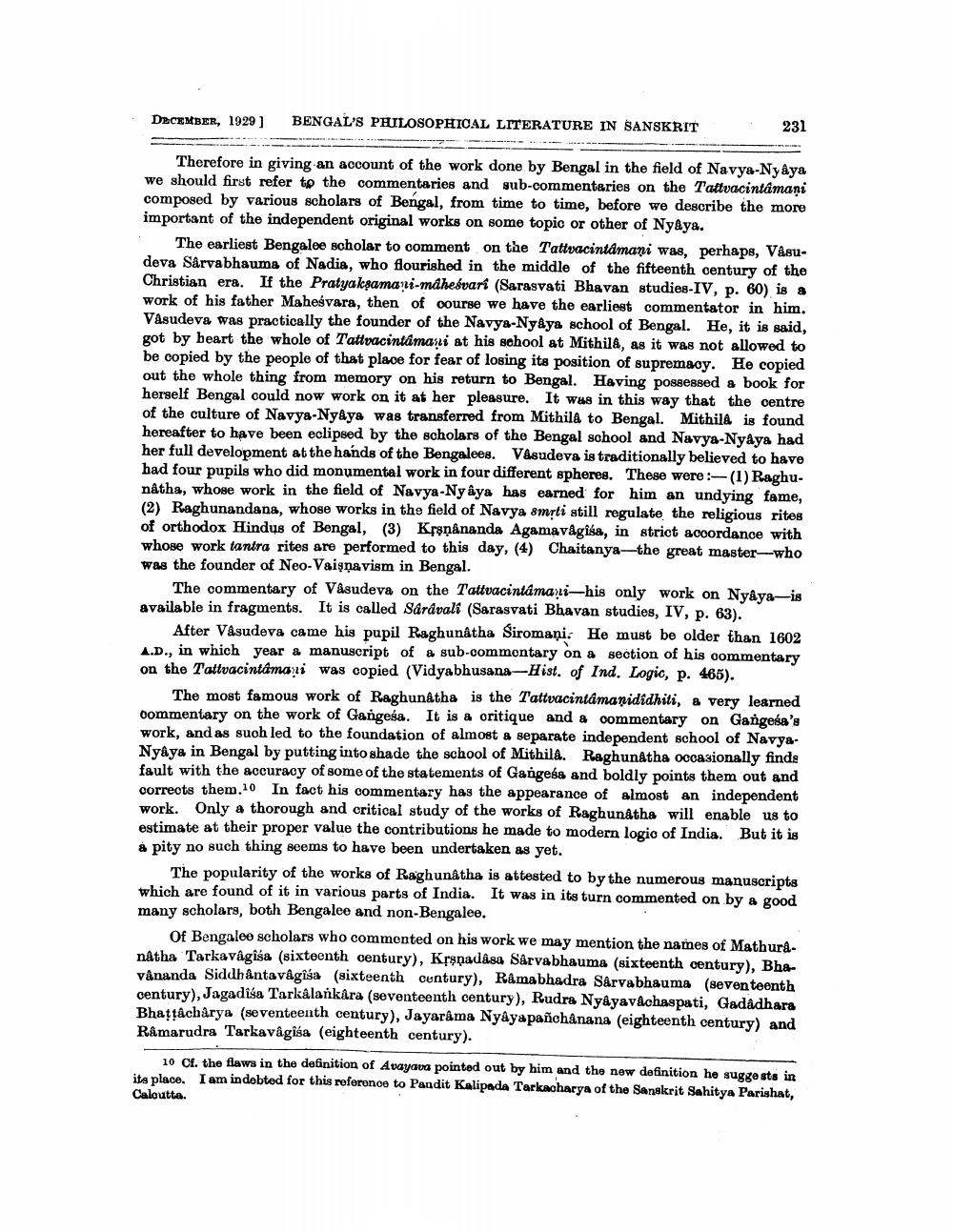________________
DECEMBER, 1929]
BENGAL'S PHILOSOPHICAL LITERATURE IN SANSKRIT
231
Therefore in giving an account of the work done by Bengal in the field of Navya-Nyaya we should first refer to the commentaries and sub-commentaries on the Tattvacintamani composed by various scholars of Bengal, from time to time, before we describe the more important of the independent original works on some topic or other of Nyaya.
The earliest Bengalee scholar to comment on the Tattvacintamani was, perhaps, Vasudeva Sårvabhauma of Nadia, who flourished in the middle of the fifteenth century of the Christian era. If the Pratyakşamani-mahesvari (Sarasvati Bhavan studies-IV, p. 60) is a work of his father Maheśvara, then of course we have the earliest commentator in him. Vasudeva was practically the founder of the Navya-Nyaya school of Bengal. He, it is said, got by beart the whole of Tattvacintamasi at his school at Mithild, as it was not allowed to be copied by the people of that place for fear of losing its position of supremacy. He copied out the whole thing from memory on his return to Bengal. Having possessed a book for herself Bengal could now work on it at her pleasure. It was in this way that the centre of the culture of Navya-Nyaya was transferred from Mithila to Bengal. Mithild is found hereafter to have been eclipsed by the scholars of the Bengal school and Navya-Nyaya had her full development at the hands of the Bengalees. Vasudeva is traditionally believed to have had four pupils who did monumental work in four different spheres. These were (1) Raghunátha, whose work in the field of Navya-Nyâya has earned for him an undying fame, (2) Raghunandana, whose works in the field of Navya smrti still regulate the religious rites of orthodox Hindus of Bengal, (3) Kroņånanda Agamavågisa, in strict acoordance with whose work tantra rites are performed to this day, (4) Chaitanya-the great master-who was the founder of Neo-Vai navism in Bengal.
The commentary of Vasudeva on the Tattvacintamani-his only work on Nvåva-is available in fragments. It is called Sardvali (Sarasvati Bhavan studies, IV, p. 63).
After Vasudeva came his pupil Raghunatha Siromaņi: He must be older than 1602 A.D., in which year & manuscript of & sub-commentary on a section of his commentary on the Tattvacintamani was copied (Vidyabhusana-Hist. of Ind. Logic, p. 465).
The most famous work of Raghunatha is the T'attvacintamanididhiti, & very learned commentary on the work of Gangesa. It is a critique and a commentary on Gangesa's work, and as such led to the foundation of almost a separate independent school of NavyaNyâya in Bengal by putting into shade the school of Mithila. Raghunatha occasionally finds fault with the accuracy of some of the statements of Gangesa and boldly points them out and corrects them.10 In fact his commentary has the appearance of almost an independent work. Only a thorough and critical study of the works of Raghunatha will enable us to estimate at their proper value the contributions he made to modern logio of India. But it is á pity no such thing seems to have been undertaken as yet.
The popularity of the works of Raghunatha is attested to by the numerous manuscripts which are found of it in various parts of India. It was in its turn commented on by a good many scholars, both Bengalee and non-Bengalee.
Of Bengalee scholars who commented on his work we may mention the names of Mathuranatha Tarkavägisa (sixteenth century), Krsnadása Sarvabhauma (sixteenth century), Bhe vånanda Siddhantavägisa (sixteenth cuntury), Ramabhadra Sârvabhauma (seventeenth century), Jagadisa Tarkalankara (seventeenth century), Rudra Ny&yaváchaspati, Gadadhara Bhattacharya (seventeenth century), Jayarama Nyâya pañchanana (eighteenth century) and Râmarudra Tarkavägisa (eighteenth century).
10 Cf. the flaws in the definition of Avayava pointed out by him and the new definition he suggests in ita place. I am indebtod for this reforonoa to Pandit Kalipada Tarkacharya of the Sanskrit Sahitya Parishat, Caloutta.




